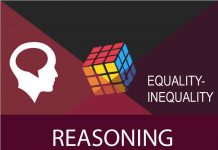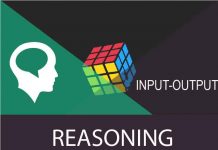Tips to Solve Mathematical Operations Problems
This topic deals with some common mathematical operations and some comparison operations.These common mathematical operations are additions, subtraction, multiplication and division and common comparison operations are greater than, less than and equal to.Questions on mathematical operations are designed to test a candidate’s skill in mathematical operations.Usual mathematical symbols are converted into another form by either interchanging the symbols or using different symbols in place of usual symbols in order to make simpler calculations look tedious.
There are mainly two types of questions which are asked in various competitive exams.
- Problem Solving by Substitution
- Deriving the Appropriate Conclusions
Type I: Problem Solving by Substitution
In this type, we are given some substitutes for various mathematical symbols or numerals. The candidate is required to put in the real signs or numerals in the given equation and then solve the question as required.
BODMAS RULE
While solving a mathematical expression, proceed according to BODMAS Rule.
For Example:
Ques- If ‘+’ means ‘minus’, ‘x’ means ‘divided by’, ‘÷’ means ‘plus’ and ‘-‘ means ‘multiplied by’, then which of the following will be the value of the expression?
24 x 6 – 3 ÷ 4 +7 = ?
Soln. – 24 x 6 – 3 ÷ 4 +7 = ?
24 ÷ 6 x 3 + 4 – 7 (using real mathematical symbols)
4 x 3 + 4 – 7 = 12 + 4 – 7 = 16 – 7 = 9
Ques – If P denotes ‘multiplied by’, T denotes ‘subtracted from’, M denotes ‘added to’ and B denotes ‘divided by’ then 28 B 7 P 8 T 6 M 4 = ?
Soln. – Using the correct symbols we get the new expression,
= 28 ÷ 7 x 8 – 6 + 4 = 4 x 8 – 6 + 4
= 32 – 6 + 4 = 36 – 6 = 30
Type II: Deriving the Appropriate Conclusions
Such questions have certain relationships between different sets of elements and is given (in terms of <,>,=) using either the real symbols or substituted symbols.
In the following questions, the symbols @, $, %, # and © are used with the following meanings illustrated—
(i) ‘X @ Y’ means ‘X is not smaller than Y’.
(ii) ‘X $ Y’ means ‘X is not greater than Y’.
(iii) ‘X % Y’ means ‘X is neither smaller than nor equal to Y’.
(iv) ‘X # Y’ means ‘X is neither greater than nor equal to Y’.
(v) ‘X © Y’ means ‘X is neither smaller than nor greater than Y’.
In each of the following questions assuming the given statements to be true, find out which of the two conclusions I and II given below them is/are definitely true.
Give answer— (1) If only I is true.
(2) If only II is true.
(3) If either I or II is true
(4) If neither I nor II is true.
(5) If both I and II are true.
Statements : P $ T, T @ L, U % L
Conclusions : I. P @ L II. U©L
>—%
≥—@
=—©
<—#
≤—$
Statement – P ≤ T , T ≥ L, U > L
P ≤ T ≥ L < U (By combining three statements)
Conclusions – P ≥ L : No
U = L : No
So, Neither Conclusion I nor Conclusion II follow






















